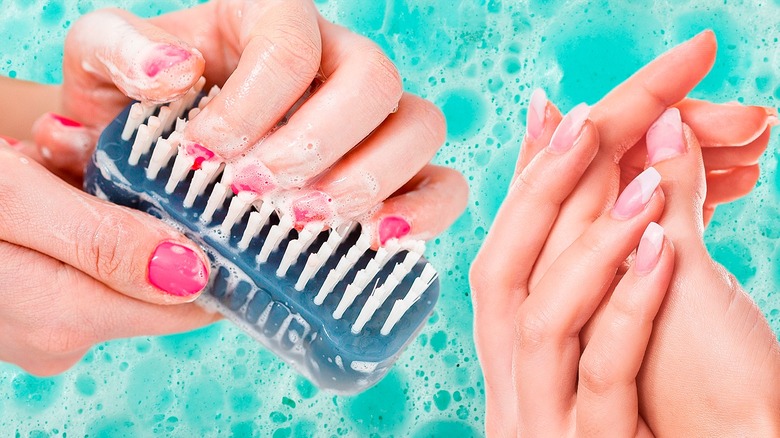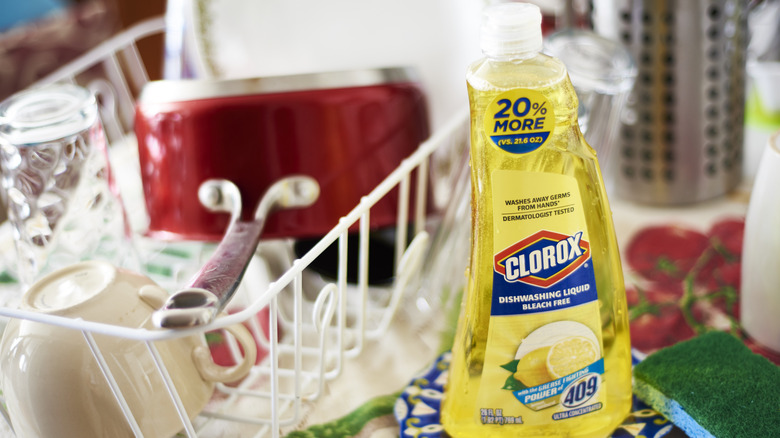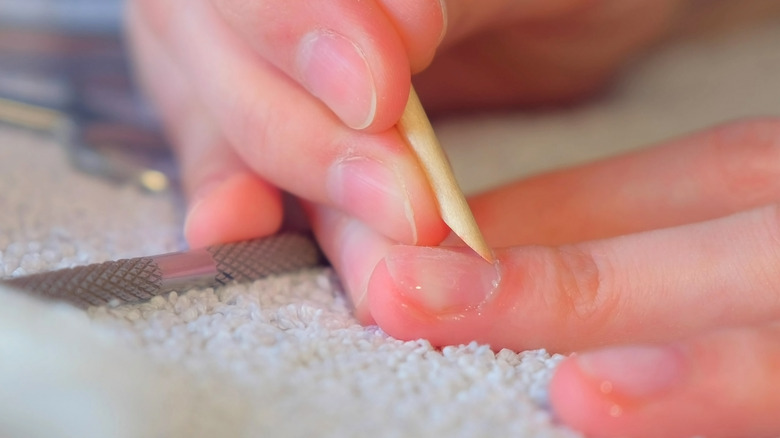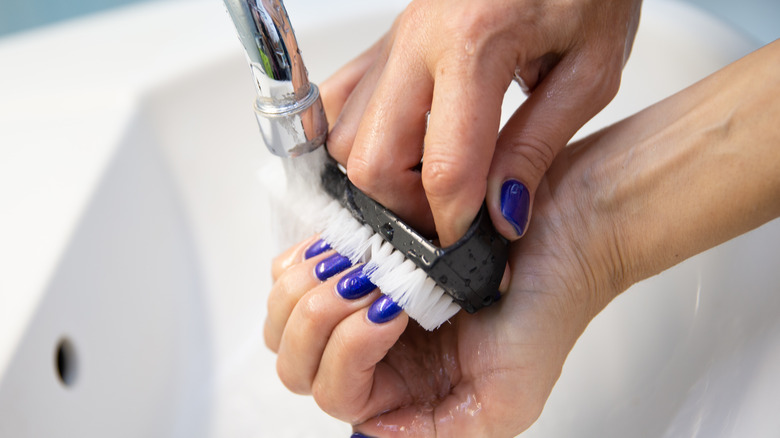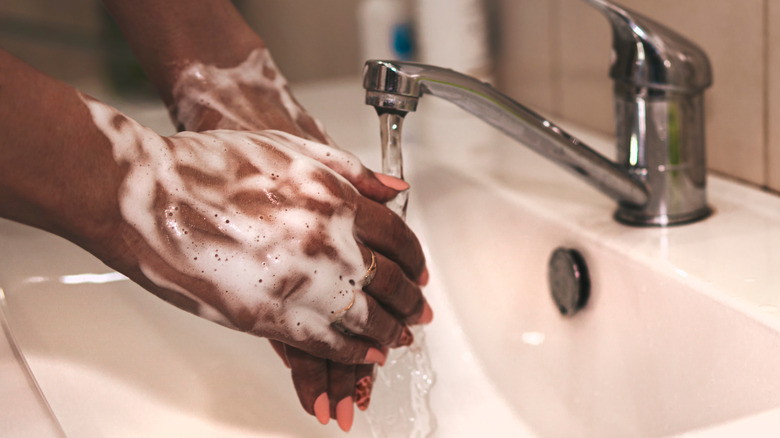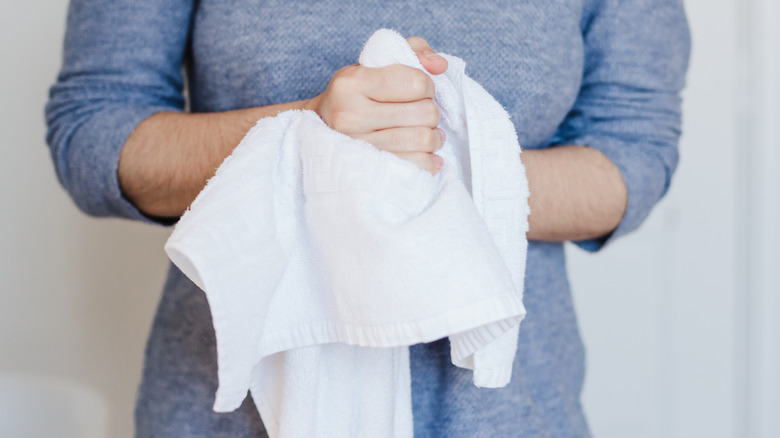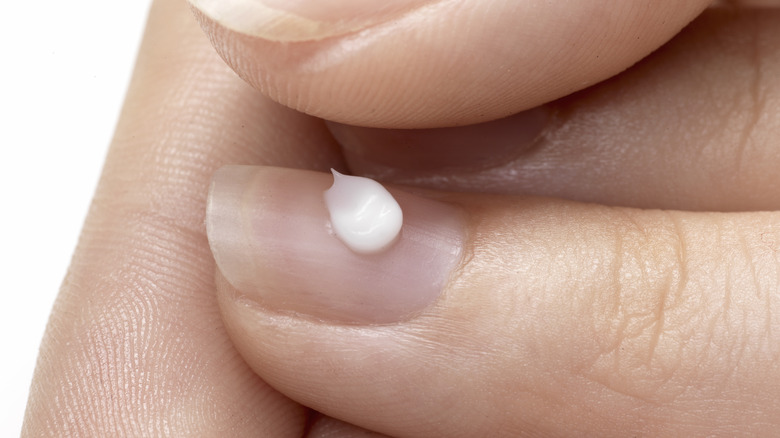Our Best Tips For Cleaning Under Your Nails
If you've ever looked under your nails, you know it can get pretty gross under there. We use our hands for everything, and they're constantly in contact with things that could be deemed a bit sketchy. Frankly, there's no telling what sort of gunk you have under your nails until you actually clean them.
According to the Centers for Disease Control and Prevention (CDC), nails are not only a hotbed for everyday dirt and germs that can affect you. They can also act as carriers for pinworms, little parasites that lay their eggs around the anus. MRSA, the antibiotic-resistant Staphylococcus aureus, has also been found under nails. A 2016 study published in the Southern Medical Journal suggested that the nails can spread MRSA to others.
"You can transmit fingernail bacteria to your system by scratching, nail-biting, nose-picking and finger-sucking," biology professor at American University Jeffrey Kaplan tells the Chicago Sun-Times. While that's the case, you still can't escape all the madness under your nails. "When surgeons scrub for surgery and then they test their hands, there's always bacteria under the fingernail, and you can't get rid of it," Kaplan adds. However, just because you can't remove all the bacteria doesn't mean you shouldn't be thoroughly cleaning under your nails as often as possible. In fact, the CDC wants you to do it every time you wash your hands.
Wash your nails with dish soap
You may think that dish soap sounds like a harsh cleaning option for under your nails, but it's exactly what you need. Dish soap isn't just made to kill bacteria, but it cuts through substances like oil and grease, per Apartment Therapy. Even if you never touch anything greasy, just being a human means you're covered in natural oils called sebum.
"[Sebum is] a complex mixture of fatty acids, sugars, waxes, and other natural chemicals that form a protective barrier against water evaporation," board-certified dermatologist Karen Hammerman tells Allure. "What we call 'oil' on our skin is made up of more than just sebum ... It also contains a mixture of sweat, dead skin cells, and tiny particles of whatever else is in the dust floating around you."
While it may not technically be "oil" as Hammerman points out, it's still something that naturally accumulates under our nails every time we scratch a part of our body or our head. Although all soaps are beneficial in their own way, because dish soap brings its grease- and oil-fighting properties to the equation, it should be your go-to for under your nails.
Use a cuticle stick
Despite the name, these pointed and/or angled sticks made of wood or steel aren't just for gently pushing back your cuticles. Their shape makes them really easy to use under fingernails to clean out grime, grease, and invisible bacteria in a safe way because they're made for in and around the nails and nail beds.
While washing your hands, reach for your cuticle stick and gently push it under your nails, one at a time, so you can scoop out what's in there. You want to be careful not to break the skin because not only will it hurt, but it's the last place you want to accidentally create an open wound. According to a 2015 study published in the World Journal of Emergency Medicine, 5% of hand lacerations end up with an infection and these types of hand injuries account for 8% of emergency room visits. It's not a huge percentage, but it's still not a category you want to find yourself in if you can avoid it. Be gentle, and if it hurts, stop digging deep. Put down the stick you're wielding, and either take a break or try something less invasive.
Invest in a nail brush
Nail brushes are equal parts great and not-so great. On one hand, they're a fantastic alternative to cuticle sticks for those who don't have a gentle touch and are likely to dig too vigorously for grime. On the other hand, nail brushes — if not properly cleaned — can become a home for bacteria and fungus, so they require more upkeep than a disposable wooden stick.
To keep the brush clean and bacteria-free, you never want to leave it in the shower or sitting in a puddle of water on the sink. Instead, you want to keep it in a dry place after each use. When you wash your nail brush, completely submerge it in a dish of warm water and add three drops of antibacterial tea tree oil. You'll want to move the brush around so the solution can disperse between the bristles for 30 to 45 seconds. Then, replace the tea tree mixture with warm water and make the same movements in the dish to rinse it. Lastly, leave the brush bristles down on a towel to dry, per Stylight. How often you do this has to do with just how much you keep brushing out from under your nails. For the sake of argument, never go more than two weeks without cleaning your nail brush.
Use lukewarm water
Although we associate scorching hot water with cleanliness, you want to back away from the hot stuff when it comes to nail care. According to the Mayo Clinic, exposing your nails repeatedly to harsh conditions — like very hot or very cold temperatures — can weaken them. Because of this, you want to wash them with lukewarm water when cleaning your nails.
When nails become weakened, they can easily split, break, or become so bendable that they eventually snap, per Healthline. If this happens, you'll have no nails to keep clean and no one wants that. Keep that water lukewarm both when you're lathering up and rinsing off your hands and nails. Also, you should steer clear of hot water when it comes to your entire body, as it can lower sebum levels, making your skin excessively dry, per Healthline. Moisturizer can help you maintain your skin's hydration level.
Dry your nails thoroughly
After you've scrubbed those nails to near perfection, you need to thoroughly dry them. This is an important step in your cleaning process because like anything that's faced with a damp environment, pathogenic organisms can become trapped and bacteria can easily grow, per Hair Essentials Salon Studios. Considering you just scrubbed out a bunch of bacteria, it makes no sense to allow for more to immediately start growing. There's also the fact that by not properly drying your nails, you can cause damage.
"Too much moisture or prolonged exposure to moisture causes the nail to swell with water and become soft," Dr. Shirin Peters tells Prevention. "The end result is a soft and brittle nail that is susceptible to damage from minimal trauma." In other words, once you're done cleaning with lukewarm water and dish soap, you can't just shake your hands dry and go on with your day. You need to dry each one with a towel.
Moisturize
Yes, the underneath part of your nails, as well as the top, should be moisturized daily — especially after you clean them. According to WebMD, using moisturizers that include urea, phospholipids, or lactic acid among their ingredients is the best option when it comes to nail health. Un-moisturized nails run the risk of becoming dry and brittle. This can lead to a nail infection like paronychia, which occurs when bacteria has made its way into the skin surrounding the nail, per the Cleveland Clinic. Bacteria really is the bane of the nails' existence, isn't it?
If you keep your tools and dish soap within arm's reach, cleaning under your nails doesn't have to be something you need to think about, but rather something you just inherently do. Once you get into the habit of paying attention to your under-nails, it will become part of your routine, and that's exactly what you — and the Centers for Disease Control and Prevention — want.
